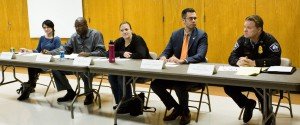By MARGIE O’LOUGHLIN
The Longfellow Community Council (LCC) convened a four-person panel of experts to address neighborhood safety concerns on Nov. 9.
The panelists were Shun Tillman, 3rd Precinct Community Crime Prevention Specialist; Alyssa Dotson, neighborhood block club leader; Andrew Johnson, Ward 12 councilperson; and Thomas Stiller, 3rd Precinct lieutenant. The event was moderated by LCC Board Member and East Lake librarian Anna Sheppard.
 Photo left: The panelists for LCC’s Community Safety Meeting agreed that reducing crime in Minneapolis happens block by block—but it takes concerned citizens to get it going. (Photo by Margie O’Loughlin)
Photo left: The panelists for LCC’s Community Safety Meeting agreed that reducing crime in Minneapolis happens block by block—but it takes concerned citizens to get it going. (Photo by Margie O’Loughlin)
Before the panel discussion began, LCC’s program manager Ashleigh Walter presented the results of the recently completed community safety survey. One hundred and forty people responded and, overall, the survey indicated that people feel safe in their neighborhood, have faith in their police, and believe that police response times to emergencies are reasonable.
Respondents identified the area around Lake and Hiawatha as feeling the most uncomfortable: the underpass, the light rail station, and the nearby Hi-Lake shopping area all got poor marks for perceptions of safety. People responded overwhelmingly positively to participation in block clubs and related activities.
There has been a recent spurt of home and garage break-ins in Longfellow. What’s the best way to reduce crime on your block? Join an existing block club, or start one from scratch. “There are a lot of advantages to being involved with block clubs,” Dotson explained. “Everything from learning to work effectively with the 3rd Precinct police officers to getting assistance with neighborhood problems and issues. And, the best part, being known in your neighborhood and getting to know others.”
Block Club leader training is held nearly every month, with the exception of December. Contact shun.tillman@ci.minneapolis.mn.us to learn more or to register for the next training session.
On the subject of community policing, Stiller (a 22 year veteran of the Minneapolis Police Department) said, “This is a very busy precinct, and public safety is our #1 priority. Regarding improving community relationships, we are adding more beats and more beat officers."
Stiller explained that "a beat is a specific area, like 46th and Hiawatha, where the same officers regularly patrol on foot or bikes. The officers assigned to beats are there because they want to be there. Neighborhood residents and business owners get used to seeing them, which makes their relationships stronger.”
“Every Minneapolis Police officer now wears a body camera,” Johnson added.”This took almost four years to implement, and we believe strongly that this is good for the officers as well as the citizens.”
“I’ve pushing for an added layer of transparency for the last couple of years,” Johnson continued, “a quality assurance team that would randomly review footage from body cameras. The team would be made up of volunteers. We could identify officers who are underperforming, and those who are going above and beyond their duties. This kind of QA is standard practice in almost every industry.
Surprisingly, I’m not aware of any other cities that are utilizing it. I hope the idea will be up and running by 2018.”
Additionally, two types of training have been implemented for the Minneapolis Police Department to bridge the gap between officers and citizens.
The Implicit Bias Training helps officers learn to identify their personal biases. The training underscores that every person, no matter how well-intentioned, holds biases of which they are often unaware.
The Minneapolis Police Department is more than half way through its year-long Procedural Justice Training, in conjunction with the US Department of Justice. Procedural justice focuses on the way police interact with the public—and how those interactions shape the public’s views of the police, their willingness to obey the law, and actual crime rates.
Johnson concluded by saying, “We need to continue with these kinds of trainings, and we need to hire more police officers. Our force is overworked and understaffed. The mayor’s budget for 2017 asks for funding to hire 15 more officers. Despite my own healthy impatience, I feel that slowly things are getting better around the issue of community policing.”
For anyone interested in deepening their neighborhood involvement, consider joining LCC’s Community Connections Committee. It meets the first Tuesday of every month at 6pm at the Longfellow Recreation Center, 3435 36th Ave. S.
Comments
No comments on this item Please log in to comment by clicking here